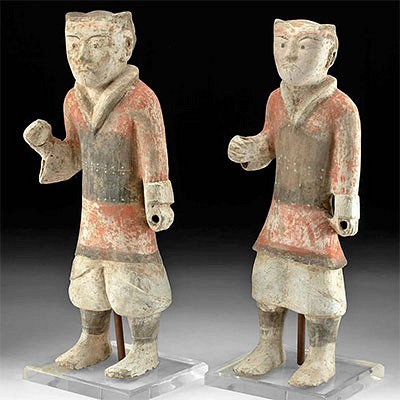Harold Frank Mixed Media Painting - Nude
Lot 188
About Seller
Artemis Gallery
686 S Taylor Ave, Ste 106
Louisville, CO 80027
United States
Selling antiquities, ancient and ethnographic art online since 1993, Artemis Gallery specializes in Classical Antiquities (Egyptian, Greek, Roman, Near Eastern), Asian, Pre-Columbian, African / Tribal / Oceanographic art. Our extensive inventory includes pottery, stone, metal, wood, glass and textil...Read more
Estimate:
$400 - $600
Absentee vs Live bid
Two ways to bid:
- Leave a max absentee bid and the platform will bid on your behalf up to your maximum bid during the live auction.
- Bid live during the auction and your bids will be submitted real-time to the auctioneer.
Bid Increments
| Price | Bid Increment |
|---|---|
| $0 | $25 |
| $300 | $50 |
| $1,000 | $100 |
| $2,000 | $250 |
| $5,000 | $500 |
| $10,000 | $1,000 |
| $20,000 | $2,500 |
| $50,000 | $5,000 |
| $100,000 | $10,000 |
| $200,000 | $20,000 |
About Auction
By Artemis Gallery
May 25, 2023
Set Reminder
2023-05-25 10:00:00
2023-05-25 10:00:00
America/New_York
Bidsquare
Bidsquare : ON-SALE! Antiquities, Pre-Columbian, Ethno, Fine Art
https://www.bidsquare.com/auctions/artemis-gallery/on-sale-antiquities-pre-columbian-ethno-fine-art-12860
ON-SALE Antiquities, Pre-Columbian, Ethno, More! Artemis Gallery info@artemisgallery.com
ON-SALE Antiquities, Pre-Columbian, Ethno, More! Artemis Gallery info@artemisgallery.com
- Lot Description
Harold Frank (American born in England, 1921-1995). "Red Linear Nude" mixed media on paper. Signed at lower right. A wonderful Abstract-Expressionist rendering of a female nude delineated with Frank's signature expressive loose brushstrokes, lyrical contouring lines, gestural marks created with instruments such as the back of a paintbrush, and a vibrant color palette - hues of red, aqua, violet, seafoam, gold with black contours highlighting the figure. According to scholar Sandie Stern, "Like his idol de Kooning, Frank chose the human figure, as his principal subject. Variations on women became a lifelong, consistent, ubiquitous theme." (Stern, "H. Frank", p. 16) Size (sight view): 13.375" L x 9.375" W (34 cm x 23.8 cm) Size (matte): 22.125" L x 18" W (56.2 cm x 45.7 cm)
Elenore Welles' essay in Sandie Stern's "Harold Frank Abstract Expressionist 1921-1995" (2001) speaks to Harold Frank's tireless exploration of medium and technique. She writes, "The overriding desire to make the artworks fresh leads to constant experimentation with materials and textures. Working with enamel and water-based paints, he explores the inherent qualities of the paper, canvas, and corrugated board, seeking to achieve unusual effects with the back of a brush, a razor, or a screw driver. He looks for surprises."
According to scholar Sandie Stern, "Although he never married, Frank searched for the perfect woman again and again in his endless, poignant portraits and paintings of the women. His abundance of female portraits attest to this. He was frustrated, yet unwavering. Art's human premise reflected his most intimate yearnings. Like his idol de Kooning, Frank chose the human figure, as his principal subject. Variations on women became a lifelong, consistent, ubiquitous theme." (Stern, "H. Frank", p. 16)
Harold Frank immigrated with his family to the US through Ellis Island. Growing up in the tenements of the Lower East Side in New York City during the era of the Great Depression and World War II, Frank found Abstract Expressionism to be the ideal means to explore the angst of his world. He once stated, "I can live with the abstract. Life is a mystery."
Frank studied at the Art Students League in New York, the National Academy of Design, the Pratt Institute, the Chouinard Art Institute, and UCLA where he was a colleague of Richard Diebenkorn (American, 1922-1993), an artist who is oftentimes associated with Abstract Expressionism as well as a pioneer of the Bay Area Figurative Movement. In addition to Diebenkorn, Frank's influences include DeKooning, Picasso, Matisse, and Rouault. While he also created landscapes, non-objective abstract compositions, and still-life paintings, figures and head studies were the predominant theme of his oeuvre.
For more about Harold Frank, see Sandie Stern's monograph "Harold Frank Abstract Expressionist 1921-1995" (2001).
Provenance: private Santa Fe, New Mexico, USA collection, acquired via descent, purchased from artist on June 25th, 1973
All items legal to buy/sell under U.S. Statute covering cultural patrimony Code 2600, CHAPTER 14, and are guaranteed to be as described or your money back.
A Certificate of Authenticity will accompany all winning bids.
We ship worldwide and handle all shipping in-house for your convenience.
#175901Signed at lower right. Very nice with vivid imagery and hues. Verso shows collection label, remnants of tape around peripheries, and paint splatters on verso.Condition
- Shipping Info
-
All shipping is handled in-house for your convenience. Your invoice from Artemis Gallery will include shipping calculation instructions. If in doubt, please inquire BEFORE bidding for estimated shipping costs for individual items.
-
- Buyer's Premium



 EUR
EUR CAD
CAD AUD
AUD GBP
GBP MXN
MXN HKD
HKD CNY
CNY MYR
MYR SEK
SEK SGD
SGD CHF
CHF THB
THB














